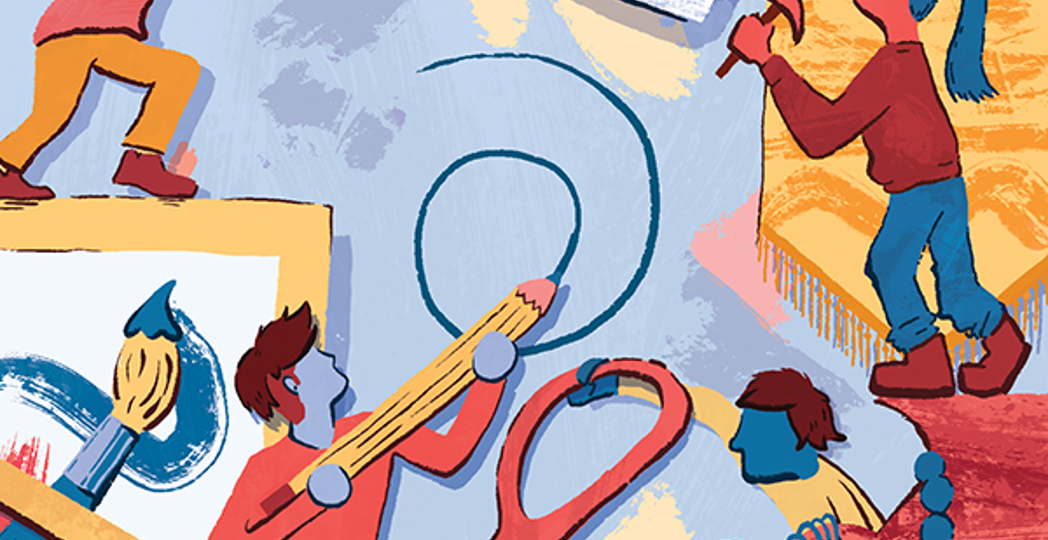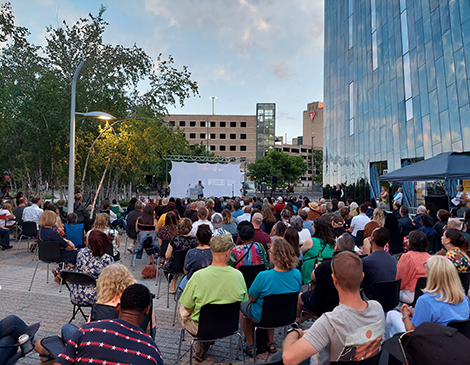Cleveland Artists Push for a New, Homegrown Festival
by Robin Goist | Apr. 29, 2024 | 9:00 AM

Emily Zhang, Courtesy Collective Arts Network
On the day before the eclipse, about 40 local creatives gathered in Artful Cleveland to collaborate on a new creative project outside of their typical mediums. The room of painters, sculptors, fiber artists, installation artists, performing artists, gallery owners, art teachers, designers and others brainstormed about what kind of new art-focused event they would like to see in Northeast Ohio.
Below rainbow-colored light fixtures and under the watchful eye of giant Day of the Dead skeleton sculptures, they discussed and, as you might expect, offered creative visions. Someone proposed three weeks of exhibits in rotating galleries, culminating in a final celebration; another suggestion was to showcase art in a five-story city building, with each floor dedicated to a different theme, and live music and performance art outside; one person offered the
prospect of an infinite experience that moves throughout venues in the city.
Liz Maugans, known by some fellow local artists as an “arts evangelist,” kicked off the meeting and took notes throughout, while another artist and art educator, David King, facilitated the conversation. With a Sharpie and a poster board, King notated the various ideas. At the end of the meeting, the board was filled with multicolored stickers indicating which suggestions were the most popular, although this was just one step in the ideation stage.
“This might be messy work,” Maugans acknowledged at the outset of this meeting, the second of its kind, “but it’s going to be, hopefully, fun and joyful.”
RELATED: For Art's Sake: Liz Maugans Makes Her Mark
The desire for such an event began in February, when the FRONT International Cleveland Triennial and CAN Triennial — both scheduled for 2025 — announced they would be canceled indefinitely. Cleveland-area artists recognized this void and started conceiving of what could take their place. In meetings like this one and in a Facebook group called “Quest for the Fest,” folks are collaborating in a grassroots effort to establish a new, unique event — one that’s entirely of their own making.
The Rise and Fall of the Triennials
Cleveland arts philanthropist Fred Bidwell began planning FRONT in 2016, on the heels of the success of Transformer Station, which was the Fred and Laura Ruth Bidwell Foundation’s first major project.
Bidwell considers the visual and performing arts center on West 29th Street and Church Avenue to have been transformational — “excuse the obvious pun,” he says — in the revitalization of Ohio City’s Hingetown neighborhood. “I was thinking, well, if a project like that could make such a big difference in the neighborhood, could a bigger project based on contemporary art have an impact on a whole city or region?”
RELATED: The Bidwells Leave a Legacy With Transformer Station
That led to FRONT: a world-class exhibition, competitive with New York, Los Angeles and European cities, giving international artists a platform in Cleveland, alongside some regional and local artists.
The first two editions of FRONT, in 2018 and 2022, were outstanding successes, Bidwell says: More than 100 artists from around the world were exhibited at more than 30 venues visited by hundreds of thousands of patrons, many from out of town, out of state or out of the country. However, with a $5.5 million budget for each edition, it was an expensive and
complicated effort, Bidwell says.
“We’re still reeling from and discovering the damage from the pandemic, and I would say that the repercussions of the pandemic had a big impact on FRONT’s ability to raise funds for a 2025 edition,” Bidwell says. “A lot of funders have changed their focus away from arts and culture and more towards community social justice, health and welfare — for a very, very good reason. And it became very clear in 2023 that we were not able to get the same kind of support that we had for the prior editions.”
The FRONT board did not want to scale back, delay or otherwise compromise the event, and preferred to “depart on a high note” rather than risk the international reputations of FRONT and Cleveland by doing something that wasn’t up to the standards of the first two editions.
It mirrored what also happened with the CAN Triennial — an event created to satisfy local artists who clamored for more of a platform beyond FRONT.
Michael Gill, executive director, editor and publisher of CAN (Collective Arts Network), held the first CAN Triennial in 2018 at 78th Street Studios. The second, in 2022, took place at 16 different venues in neighborhoods across Cleveland.
“In 2016, there was huge buzz about the prospect of the FRONT Triennial because a big international art deal in Cleveland would be pretty exciting to the art scene, but when the list of artists came along, Cleveland artists were not well-represented, and neither were the organizations,” Gill says. “So, I thought we could create a regionally-focused triennial: take advantage of that buzz, share the spotlight, make a totally Cleveland event.”

(Photo courtesy Collective Arts Network)
Before thoughts of the triennial, CAN mostly focused on its local arts publication, CAN Journal, a quarterly magazine and website. The first CAN Triennial showcased about 90 local artists and was a success, Gill says, although it required CAN to roughly double its budget, from about $250,000 to half a million.
“After the 2022 triennial, once again, [there was] enormous enthusiasm,” Gill says. “However, it was more difficult to raise money that time. I think we actually spent a little more than we raised for the event.”
Similarly to FRONT, CAN struggled with fundraising ahead of the 2025 event, as Gill noted that many of the donors and other supporters had shifted their focus away from art and toward health, human services and social justice. CAN also faced bandwidth concerns, with Gill as the only full-time staffer.
Ultimately, the organization decided to cancel its 2025 triennial — before it even knew about FRONT’s cancellation.
“Looking at the challenges,” Gill says, “we just had to make the decision that we need to focus on the main thing that we do, which is to provide communication for galleries and reporting on the art scene. It’s not really our focus to produce exhibits.”
Now, in lieu of either triennial, CAN might have a new event in 2025 to cover.
A New Festival
Cleveland’s arts world has had a tumultuous couple of years, beyond just the canceled triennials.
The scene also lost the Cleveland State gallery at Playhouse Square, effectively ending the Robert Thürmer People’s Art Show, a free, unjuried exhibition open to everyone, with all entries exhibited.
Coincidences, lining up: The losses demonstrate how many parts of the art world can be in flux, out of the artists’ control.
Northeast Ohio’s arts community is reflecting on these events — what worked, what didn’t — and envisioning what sort of festival they would like to see next year instead.
In Maugans’ view, decisions about what’s best for Northeast Ohio artists have been made by people who are not artists.
“So, why not have artists do this and figure out how we can increase our public accessibility and have that engagement, which is largely not happening across Cleveland?” she says.
Both Maugans and King reflected on the state of the arts while inside the lobby of Worthington Yards, a Downtown apartment building where Maugans has established a gallery to display local art. We sat among paintings and sculptures from an exhibit called “Sage Wisdom,” featuring work from artists 65 or older.
RELATED: Tinnerman Lofts Boasts Art-Inspired Designs and Communal Comfort (First Look)
“There is a big void now,” King says. “How can we fill the void? What does everybody want? How can we keep the momentum going?”
These efforts are intentionally decentralized and democratized, Maugans said, and the conversations thus far have been big-picture brainstorming, “blue sky ideating,” about what a new event could look like and how it should complement existing events including Ingenuity Fest, Cleveland Asian Festival, Firefish and the Waterloo Arts Fest.
“I think we all felt that if we want to try to sell art, that we will fail,” she said at the event. “But, if we go in with a different kind of energy, and something that is radically fun, accessible to all, that there aren’t a lot of barriers, and that we can get intergenerational artists, from high school seniors to college students working with emerging artists and seasoned artists — what better energy do you need?”
Maugans has brought creatives together, but she isn’t entirely leading the effort.
King calls her the “soup-stirrer,” and says they’re welcoming any and all cooks into the kitchen.
Once the festival starts to take shape, Maugans would like to tap creatives with various skill sets such as budget and finance, project management, and marketing. The group has also begun to consider sponsorships and getting a fiscal agent, possibly with a community development corporation.
“Post-pandemic, people need a beautiful thing like this,” Maugans says. “People will see the two triennials that aren’t happening as a loss, a lack and a gap, and the People’s Art Show for sure. So, we’re going to be the fillers. We also might identify that this is too hard and it’s not going to happen — it’s impossible to know, and that might be one of the outcomes — but we won’t know until we get into the meat of it. But I’ve been really surprised at how many people are excited about it.”
For more updates about Cleveland, sign up for our Cleveland Magazine Daily newsletter, delivered to your inbox six times a week.
Cleveland Magazine is also available in print, publishing 12 times a year with immersive features, helpful guides and beautiful photography and design.
Trending
-
1
-
2
-
3
-
4
-
5










